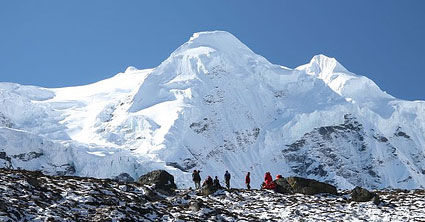
Mera Peak (6461m) is the highest trekking peak in Nepal and a suitable challenge for a first time climb in the Himalayas. Our specially devised itinerary allows optimum time for building fitness and acclimatisation - key factors that have contributed to our success record. On our trek - that leads though the traditional Sherpa villages of the Solu Khumbu as well as blue pine and rhododendron forest trails of the Hinku Valley - you\'ll be sure to appreciate why we have selected this magnificent approach to the base camp. Fully acclimatised we ascend to a high camp just below Mera La and prepare for our attempt on the main summit of Mera Peak. The ascent is not technically demanding and offers unequalled views of Everest, Lhotse and Makalu.
Mera peak is situated in the Everest region in a remote valley, and is a non technical mountain to ascend. It is suitable for anyone of average or above average fitness. When you stand upon the summit, spread before you will be an unbelievable panorama of the highest peaks in the world such as Mt. Everest, Makalu & hundreds of other beautiful mountains. We follow the original Everest expedition route at the trail head from Lukla, cross spectacular gorges and climb the peak before entering Sherpa regions of Solu Khumbu, the wilderness of Hinku Valley. Ample time for acclimatisation will be allowed en route to our base camp on the Mera La Pass.
Trip Itinerary
Day 1: Arrival in Kathmandu-Transfer to HotelYou will be met at the airport by our Adventure Jaljale representative and transfered to your hotel in Kathmandu. Rest at the hotel and briefing about the trip. There should be time to explore the city\'s many charms on your own too. Overnight (O/N) in Kathmandu (breakfast included).
Day 2: Rest and Preparation or Sightseeing.
For those who prefer a quiet day or need to make some last minute preparations, today is the day. For others the program is as follows:
Leave for full day sightseeing in Kathmandu valley including the holiest site in Nepal: the Hindu temple complex at Pashupatinath (a UNESCO world heritage site) & the biggest Buddhist Stupa at Boudhanath. We can also visit the Shyambhunath a 2000 year old temple colloquially known as the "Monkey Temple" and visit Patan city of fine arts.
For all: In the evening there wil be a briefing at your hotel or at the office. O/N in Kathmandu (breakfast included
Day 3: Fly to Phaplu, trek to Nuntala 2350m.
The flight is less than an hour but an eye-opening introduction to rural Nepal. On landing, we will feel like we\'ve stepped back in time. We cross the Trakshindo La (3071m), descending past the Trakshindo gompa to Nuntala, which is also called Manidingma. Overnight at teahouse or camping. (all meals and hot drinks included)
Day 4: To Kharikhola.
We cross the Dudh Kosi river and climb to the pretty village of Jubing, the only non-sherpa village of the whole trek. Passing through the terraced fields of Kharikhola you realize just how much work these people put into farming. Where we stay will depend on where we make it to. Overnight camping. (all meals and hot drinks included)
Day 5: Pangkongma.
We leaving the main route and head up towards Kharikhola. We rise to a spur pass, Khari La (2,990m). This used to be the main path up from Jiri before the new one below was made. The evidence of busier times is offered by the ruins of the old bhatti tea house. The view north and west is fantastic all the way to Cho Oyu. We will stop for lunch at a small lodge which seems suspended over the wide Kharikhola valley below. We can see the notch of the Pangkongma La ahead only just higher than this little eyrie. The afternoon brings us through gorgeous forests with many high waterfalls, to the handsome village of Pangkongma (2,846m), where we camp in the grounds of a fine Sherpa family house, the last of these robust stone buildings we will see before our return to Lukla. Overnight camping. (all meals and hot drinks included)
Day 6: Rest and acclimatisation at Pangkongma.
Day 7: Narjing Dingma.
In the cool of the morning we head up toward the Pangkongma La pass behind the village, and it is not long before we arrive at its distinct notch (3,180m), marked by some very ancient chortens. We have entered the Hinku valley and immediately there is a feel of unspoilt remoteness. Across the valley are thick forests broken only by a few kharka pasture settlements. Snow peaks top the ridge opposite but it is not until we come round the corner that Mera comes into view guarding the head of the valley. From this angle it looks very impressive, and anything but easy! We descend through some scattered settlements and have lunch at one of the lower ones.The Hinku river, seen crashing through inaccessible gorges down from the north, is tucked away here, far below, reappearing as it winds its way south into incredible hazy distance. Here is another fantastic eyrie viewpoint. From here we can see our campsite, seeming so close, and can follow our route of the next few days running along the ridge above. The afternoon takes us down an steep path to cross the river. The most dramatic waterfall so far plunges down the opposite bank. The climb up is softer and takes us into some deep forests before emerging to camp in the pastures of Narjing Dingma (2,650m), a settlement of bamboo huts. Overnight camping. (all meals and hot drinks included)
Day 8: Chalem Kharka.
The forests continue as we ascend, now mainly rhododendron. From the Surkie La (3,085m) we head north along the ridge, and the whole of eastern Nepal opens out in front of us, over the wildly remote Hongu valley, with the solitary bulk of the Kangchenjunga massive marking the Sikkim border. As we head up this ridge today and tomorrow, we will pass from side to side with immense dramatic views either way. This first section we call ‘Raspberry Ridge’, and these delicious wild berries are ripe to perfection in October. We have lunch and later camp (3,450m) in the grassy pastures, kharkas, that occasionally widen the ridge. Overnight camping. (all meals and hot drinks included)
Day 9: Khula Kharka.
From here the way up the ridge is cragged with lichen rocks and heathers, and we wind our way up over several rises. The ridge narrows as dramatic gullies drop away steeply on either side. Over a final crest (4,330m) we reach the unexpected suspended ledge of the lakes of Panch Pokhari - five lakes, the sacred number. This is a place of pilgrimage for both Buddhists, who line the edges of the lakes with chortens, and Hindus, who leave a forest of tridents, the symbol of Shiva the mountain-born god of destruction and re-birth. This is a very potent, evocative site. A short descent beyond brings us to Khula Kharka (4,120m), our campsite. Overnight camping. (all meals and hot drinks included)
Day 10: Khote.
Another excellent day, first contouring the heathery slopes, now firmly on the Hinku side of the ridge. Dwarf juniper shrubs turn gradually into trees again, before we descend steeply to the phenomenal cascading junction of two mountain torrents, crashing down through tall pine forests all around our lunch site. These totally unspoilt forests become even more majestic, as we soon rejoin the main river, crossing it to continue up the west bank and reach Khote (3,480m) where we will camp. This site was devastated by the flood of ‘98 when the Sabai Tcho glacial lake broke its moraine dam. The tea huts have now been rebuilt but the previously grassy campsite is now a beach! The final crest of the Mera ridge including the summit is clearly visible up at the end of the valley ahead. Overnight in teahouse or camping. (all meals and hot drinks included)
Day 11: Tagnak.
The forest gives way to open valley again by mid-morning, revealing the peaks which line either side. A small Buddhist gompa in the rock wall above the path, contains some fine Buddha statues within. The valley swings eastward into a new array of peaks and the route up toward the Mera glacier comes into view. We should reach the surprisingly well-established summer settlement of Tagnak (4,140m) by lunch time, and here we set up camp. Towering over our heads the sheer flank of the Mera ridge dramatically dominates the skyline. Overnight in teahouse or camping. (all meals and hot drinks included)
Day 12: Tagnak glacier acclimatisation day.
This is a useful day for boosting our adaption to the altitude by gaining as much height as we can during the day but returning to Tagnak for the night. Opposite the Mera ridge the Tagnak valley leads up to a long range of peaks connecting Kusum Kanguru North to Kang Teiga. In the morning we climb to the glacier level (about 5,000m), mostly a rocky scramble, with great views of Mera behind. Returning for lunch, in the afternoon we head up the slopes to the north to look at what is left of the glacial lake, Sabai Tsho. You can still see a distinct line, far above the current water level, marking where the water had once reached. Overnight in teahouse or camping. (all meals and hot drinks included)
Day 13: Tagnak - Khare.
This morning\'s walk up alongside the Dig glacier is easy and relaxed. The valley opens out to the north to offer stunning views of the Hinku Nup glacier and the line of peaks beyond. Behind us is the dramatic spire of the less than romantically named ‘Peak 35’, which has yet to be climbed. Only the last section up to our base camp at Khare (4,940m) is steep and reminds us that we are gaining altitude. Its a short climb and we should be there in good time for lunch. This will be our base for the next 3 nights, thoroughly developing our acclimatisation, with successively higher day ascents, descending to sleep low and consolidate our energies for the final ascent to come. We start this process this afternoon, with a gradual ascent of an excellent grassy ridge immediately behind the camp (to 5,260m) which also gives us great all round views - of the flattened ridge across the glacier which we will ascend tomorrow, and south to Mera itself, including the pass, the high camp rock outcrop and the 3 summits arrayed along the ridge. Overnight camping. (all meals and hot drinks included)
Day 14: Ridge ascent from Hinku Nup.
Today we gain more valuable acclimatisation and enjoy some stunning views as well. Following the lateral moraine of the Hinku Nup glacier into an arena of peaks and glacial lakes, we turn to ascend a grassy ridge that rises back to the south. At the top we eat our lunch surrounded by a stunning panorama of peaks including Mera itself and the whole of Hinku Himal to the north right round to the south face of Ama Dablam. We take a packed lunch with us, but top up with hot noodle soup back at base. In the afternoon we look at the principles of roping up for glacier travel, which is different from other roped climbing. Overnight camping. (all meals and hot drinks included)
Day 15: Khare - Mera High Camp.
We return to the glacier, and this time follow it round in a wide arc, keeping close under the northern flank where there are no crevasses. The last section is almost level and Mera La (5,410m) is a rounded snow col that bridges south to the main sweep of the Mera glacier coming down from the peak itself. The views that open out beyond, as we pull clear of the northern flank, are really fantastic; the Hongu valley opens out in front of us dominated by the massive south-west face of Chamlang. Makalu fills the gap to the north.
This has got to be one of the most amazing camp view points in the whole of the Himalayas. Kangchenjunga is now visible to the east above the ridge of Chamlang; the ice spire of Baruntse has appeared to the left of Makalu. Between it and the beautiful twin peaks of Ama Dablam, which now rise above the lesser peaks in the foreground, we can see the whole of the great sweeping ridge line from Nuptse up to the forbidding mass of Lhotse’s south face running through to Lhotse Shar. Over the ridge stands the summit of Everest, and the final stages of the traditional route up the south-east ridge, a view visible only from this angle (or from the summit of Ama Dablam!). Just to the right of Kang Teiga, which dominates the western foreground, we can see all the way up the Ngozumpa glacier past Gokyo to Cho Oyu, bringing our tally of 8,000 metre peaks to an unbelievable five. We are likely to get an amazing sunset. Overnight camping. (all meals and hot drinks included)
Day 16: High Camp - Mera summit - Khare.
It can seem a bit of a shock to the system to be awakened before dawn (even by smiling Sherpas bearing steaming hot tea), with the prospect of leaving our warm sleeping bags and getting ready for the cold outside - always the toughest moment of any mountaineering trip. But we soon warm up, continuing up the main glacier then crossing back to the south side as we approach the snow hump-back ridge. The first shafts of the sun hit the big peaks behind us and are soon on our own slopes, an amazing horizontal red glow. The route is still non-technical; 30º slopes, one foot in front of the other, count the steps and take a breather. Our acclimatisation will be at its peak just when we need it, and, except due to weather conditions, we have still not had anyone attempt the summit and fail (perhaps thanks to the help of our leaders who are now fluent in the language of encouragement). The slope steepens for a section behind the ridge and then we swing diagonally westward. The summit comes back into view and we are on the level summit ridge. At the foot of the final steepness we can attach to our only fixed rope on the route which safeguards this 30 metre 55º pitch.
You can jumar or not. The snow conditions are normally excellent at this early hour and the amazing moment of pulling out on top is just a few whacks of the ice axes away. After some wordless back-slapping from your co-climbers, you start to take in the panorama. The best viewpoints of the Himalayas are the chance combination of accessible height and location. Mera has this combination to perfection. It stands at the centre of the highest section of the entire range, a little bit back so the minor peaks do not obscure the major ones - 360° of the greatest peaks on earth! What with the exhilaration of reaching the summit and this incredible location is it really impossible to describe the experience to anyone before they have done it (and still we try!) We will take the time to let it all in, the achievement, the experience and then head right down to Khare. This really doesn’t take very long, and we’ll be ready for a bit of celebration, tired or not! Overnight in teahouse or camping. (all meals and hot drinks included)
Day 17: Contingency day.
There is no such thing as a guarantee of good climbing conditions in the Himalayas, so an extra day maximizes our odds in this normally fair-weather season. If we’ve done the deed already, we’ll decide whether to rest up or move on down. If we need yet another contingency day, we have an excellent alternative route not a lot of people know about, which returns from Tagnak to Lukla in a very long single day. We keep that up our sleeves! Overnight in teahouse or camping. (all meals and hot drinks included)
Day 18: Khare or Tagnak - Khote.
If we had a rest day yesterday we may want to head on today and spend an extra night in Lukla where the beers are cheap. If we’re fresh off the mountain we’ll just take it easy. Overnight in teahouse or camping. (all meals and hot drinks included)
Day 19: Khote - Chetera.
A new route has now been completed which stays high on the open hillsides west of the Hinku river, rather than wind through the forests down below. This makes for a quicker return with some fantastic views back of Mera herself from a completely different angle. Chetera (4,150m) is a small pasture by an enormous free-standing rock. Overnight in teahouse or camping. (all meals and hot drinks included)
Day 20: Chetera - Lukla.
The trail goes over a series of rises and a high plateau before we finally reach the craggy Zatrawa La (4,580m), where we look back on the Hinku wilderness for the last time and the south face of the peak we have just climbed. A gradual descent takes us towards the rocky outcrop of the Zatr Og. Changing our direction to head north we descend now steeply from the Kalo Himal, the ‘black mountains’, into the rocky slopes and cascading streams of the Sherpa populated Dudh Kosi valley. The high crags give way to forest, where we have lunch in a clearing, then to farmland as we approach the tourist bustle of Lukla (2,850m), our night stop, still high above the river. The village of our outward trek now feels like a metropolis, and a wild party is inevitable. Overnight in teahouse or camping. (all meals and hot drinks included)
Day 21: Flight from Lukla to Kathmandu.
From Lukla, we take an early morning flight to Kathmandu.
Day 22: Free day in Kathmandu
We allow for this extra day in Kathmandu in case of canceled mountain flights or other unexpected hitches. O/N at guesthouse in Kathmandu (breakfast included)
Day 23: Transfer to international airport for your final departure.
If you are interested in continuing on to the Chitwan Jungle Safari, River Rafting Adventure or any other tours you can start today.
If on the other hand your trip is at an end, we will say goodbye for now and our Airport Representative will drop you at the Kathmandu International Airport for your flight departure from Nepal.
Trip Inclusion
- Airport pickup and drop by private vehicle in Kathmandu.
- Four nights’ hotel accommodation in Kathmandu with breakfast included.
- Guided city tour in Kathmandu in private vehicle as per itinerary.
- Meals on full board (Breakfast, lunch and dinner) during trekking period prepared by our cook with Tea and coffee.
- Local fresh fruits where available.
- Surface Transport to and from Kathmandu.
- Twin sharing tented camp accommodation and equipment during the camping trek. (We will provide waterproof two men tents, dining tents, kitchen gears, dining table, chairs, toilet tents, shower tent etc.)
- Trekking map, one in a group.
- Trekking porter/Sherpa to carry your bags during the trekking 2:1, max 20 KG baggage/porter.
- All camping gear and necessary staff for carrying, cooking and building camps.
- A local government licensed English speaking Guide during the trek, the required number of cooks, porters, their food, accommodation, salary, insurance, equipment, medicine, transportation.
- Group medical supplies (first aid kit will be available).
- Boiled and purified drinking water for the trek.
- All required special trekking permits and conservation fees.
- TIMS (Trekkers\' Information Management System).
- All government taxes and our service charges.
- Farewell Dinner before departure.
Trip Exclusion
- Lunch and dinner in Kathmandu.
- Your Travel insurance (Mandatory).
- International airfare and date change or ticket re issuance charges.
- Nepal entry visa fee (you obtain a visa easily upon your arrival at Tribhuwan International Airport Kathmandu). You will require 2 passport size photos.
- Tips for trekking staff and driver. (Tipping is expected but not mandatory).
- Alcoholic drinks, cold drinks, and supplementary hot drinks
- Items of a personal nature such as laundry, phone calls and internet service.
- Personal trekking Equipments.
- Sightseeing/Monuments entrance fees in Kathmandu.
- Any others expenses not mentioned on package Includes section.
Extra Services
- The itinerary is modifiable as per needs and time frame of trekkers.
- Cost will be re calculated if the itinerary is changed.
- Additional activities may be added as per trekkers request with appropriate additional cost.
- The cost may also be affected if there is a requirement for extra guides and porters.
- For any kind of change please contact us by mail or call
Related Trips
 Mera Peak Climbing (22Days)
Mera Peak Climbing (22Days)
High Altitude: 6476 m.
Region: Everest Region
Group Size: 2-12pax
Package Cost: -
Mera Peak (6461m) is the highest trekking peak in Nepal and a suitable challenge for a first t...
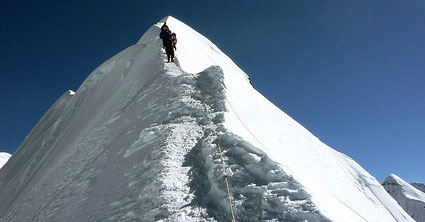 Island Peak Climbing (24days)
Island Peak Climbing (24days)
High Altitude: 6189 m.
Region: Everest Region
Group Size: 2-12pax
Package Cost: -
Imja Tse peak, at a height of 6,160 meters, is more popularly known by the name of Island Peak...
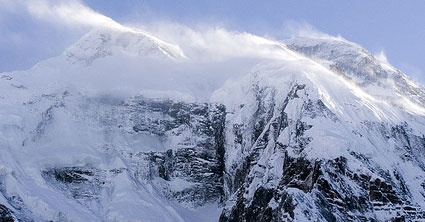 Pisang Peak Climbing (32days)
Pisang Peak Climbing (32days)
High Altitude: 6091 m.
Region: Annapurna Region
Group Size: 2-12
Package Cost: -
Pisang Peak is one of the non-expedition peaks (under 7000 meters) in Nepal and rises opposite Annap...
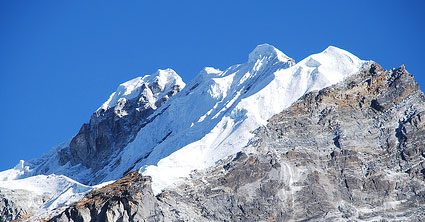 Lobuje Peak Climbing (22days)
Lobuje Peak Climbing (22days)
High Altitude: 6119 m.
Region: Everest Region
Group Size: 2-12pax
Package Cost: -
Lobuje Peak is actually made up of two distinct peaks - Lobuje East (6,119m/20,070ft) and Lobu...
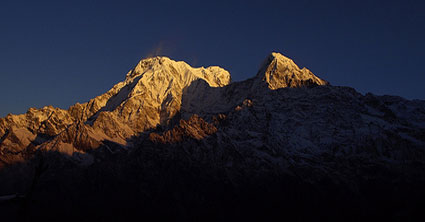 Mardi Himal Peak Climbing (21days)
Mardi Himal Peak Climbing (21days)
High Altitude: 5587 m.
Region: Annapurna Region
Group Size: 2-12pax
Package Cost: -
Mardi Himal is is a gem hidden in plain view at less than 15 miles from Pokhara it remains amo...

 I want to thanks for Travel one Nepal (P.) Ltd. for their wornderful service and support for travelling in Nepal.
I want to thanks for Travel one Nepal (P.) Ltd. for their wornderful service and support for travelling in Nepal.  I have travel lots of place in Nepal. Among them I like the services and facilities of Travel One Nepal (P.) Ltd. Thanks Travel One Nepal (P.). Ltd.
I have travel lots of place in Nepal. Among them I like the services and facilities of Travel One Nepal (P.) Ltd. Thanks Travel One Nepal (P.). Ltd. 